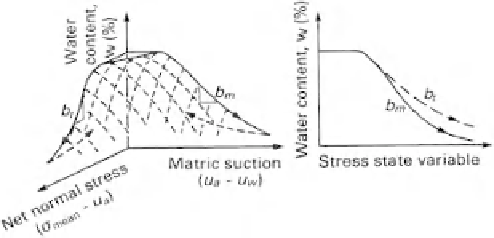Environmental Engineering Reference
In-Depth Information
The above equation is equivalent to a soil structure consti-
tutive relationship written using soil mechanics terminology.
The water phase constitutive equation can be expressed
as a change in gravimetric water content. The water phase
constitutive relation has the following form for
(Fig. 13.10). The relationships between various deformation
coefficients are explained later in this chapter. Similar but
independent constitutive relationships can be formulated for
unloading conditions.
three-
dimensional loading:
13.4.2 Use of
σ
−
u
w
and
u
a
−
u
w
to Formulate
=
b
t
d
σ
mean
−
u
a
+
b
m
d
u
a
−
u
w
Constitutive Relations
The constitutive equations for an unsaturated soil have been
formulated using the stress state variables
σ
−
u
a
and
u
a
−
u
w
. Other combinations of stress state variables, such as
σ
−
u
w
and
u
a
−
u
w
, can also be used for formulating the
constitutive relations for an unsaturated soil. As an example,
Eq. 13.56 can be rewritten using
σ
−
u
w
and
u
a
−
u
w
:
de
=
a
t
2
d
σ
mean
−
u
w
+
a
m
2
d
u
a
−
u
w
dw
(13.57)
where:
b
t
=
coefficient of water content change with respect to
a change in net normal stress,
d
σ
mean
−
u
a
, and
b
m
=
coefficient of water content change with respect to
a change in matric suction,
d
u
a
−
u
w
.
(13.58)
The above constitutive equations can be visualized as
constitutive surfaces on a three-dimensional plot. Each
abscissa represents one of the stress state variables and
the ordinate represents the soil volume-mass property
(Fig. 13.10). The
a
t
,
a
m
,
b
t
, and
b
m
coefficients become
another form of the volumetric deformation coefficients.
The volume-mass constitutive surfaces can be reduced
to two-dimensional plots which more clearly show the
relationship between the various deformation coefficients
where:
a
t
2
=
coefficient of compressibility with respect to
σ
mean
−
u
w
when using the
σ
−
u
w
and
u
a
−
u
w
stress state
variables and
a
m
2
=
coefficient of compressibility with respect to matric
suction when using
σ
−
u
w
and
u
a
−
u
w
as stress
state variables.
The water phase constitutive equation can also be written
in terms of
σ
−
u
w
and
u
a
−
u
w
:
=
b
t
2
d
σ
mean
−
u
w
+
b
m
2
d
u
a
−
u
w
dw
(13.59)
where:
b
t
2
=
coefficient of water content change with respect to
σ
mean
−
u
w
when using the
σ
−
u
w
and
u
a
−
u
w
stress state variables and
b
m
2
=
coefficient of water content change with respect to
matric suction when using
σ
−
u
w
and
u
a
−
u
w
as
stress state variables.
The
σ
−
u
a
and
σ
−
u
w
stress state variables could sim-
ilarly be used to formulate the volume-mass constitutive
relations.
(a)
13.4.3 Experimental Verification for Uniqueness
of Constitutive Surfaces
The uniqueness of proposed constitutive surfaces should first
be explored on a local scale using small stress state vari-
able changes around a state point on the surface (Fredlund
and Morgenstern, 1976). Subsequently, larger stress state
variable changes should be used to test for uniqueness of
the entire constitutive surface (Matyas and Radhakrishna,
1968; Barden et al., 1969a). Both methods for verifying the
uniqueness of a constitutive surface are briefly explained and
discussed. The sign conventions associated with volumetric
(b)
Figure 13.10
Constitutive surfaces for an unsaturated soil
expressed using soil mechanics terminology: (a) void ratio con-
stitutive surface; (b) water content constitutive surface.











Search WWH ::

Custom Search